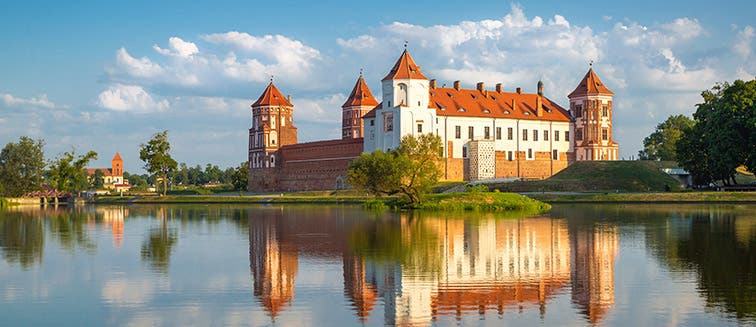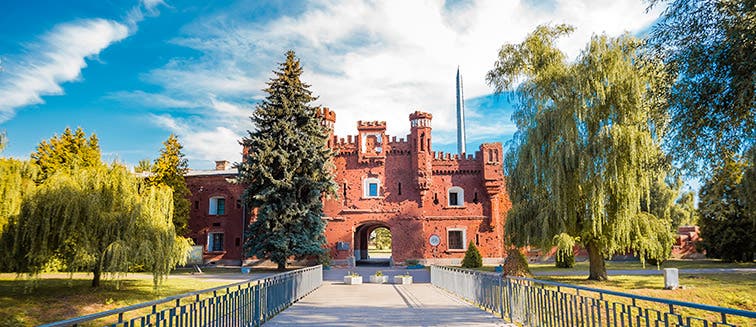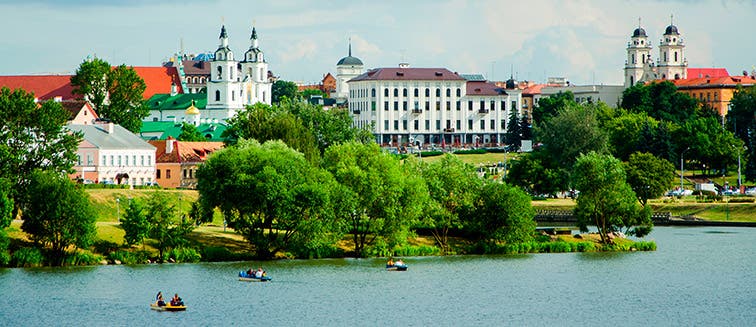Africa
Americas
Asia
Europe
Oceania
By Season
By Interest
By Group
What to see in Belarus
Historical castles of Mir and Nezvizh
- Holidays to Belarus
- Points of Interest
Tourist attractions Historical castles of Mir and Nezvizh
In Belarus, there are beautiful castles like that of Mir and Nezvich. They say that an underground passage joined them in the past and both have been included in the list of World Heritage Sites of UNESCO; the first for being a "living testimony of its turbulent history" and the second for "coming from some eminent personalities of the history and culture of the Old Continent".
Both are integrated perfectly into nature, in a striking green environment that retains its beauty all year round, although the parks and ponds show their greatest grandeur in the spring and summer months.The Mir Castle Complex, or Mirsky Complex, was erected in the city of the same name in the Karelichy district, which belongs to the Grozno region, 90 km southwest of Minsk.
The Tartar invasions in the lands of the Grand Duchy of Lithuania led to the beginning of its construction in the early sixteenth century, being completed in 1522 by the Grand Marshal, Duke Ilínich. At this time it had a mainly defensive function so a square structure was planned, with walls of 25 metres in height by 3 in width and 4 towers built in a Gothic style. A fifth tower located in the center of the west wall was the only entrance to the castle, which was accessed through a drawbridge.
From 1568 its new owners, the Radziwil Counts, gave it a more Renaissance style appearance by building a three-story palace and a moat around it inside the castle. Its facade was plastered with decorative portals of lime, plates, balconies and porches. The basement and the first floor was used as a warehouse, the second was the home of the lackeys and administrators and the third was the residence of the prince.
The subsequent war with Russia and the Northern War, from 1700 to 1721, caused the destruction of what had recently been built. In 1828 the castle passed to the Wittgenstein and after almost a century of semi-abandonment, from 1891 the property passed to the Sviatopolk-Mirsky family. The garden located on the right side was removed and replaced by a pond. A two-story palace was built near the castle and trees were planted between them. An artificial lake was dug in the southern part and an Italian garden was built in the northern part as well as a surrounding park. Its complete restoration was achieved in the third decade of the 18th century.
In 1939 after the accession of the country to the Soviet Union the castle passed into the hands of the state. During the German occupation, from 1941 to 1944, it suffered a lot of damage and housed a Jewish ghetto and a prison camp and after its liberation and until 1956, it was the main source of work for the locals, so parts of its interior grandeur were ost.
The Castle of Mir is a magnificent example of the late medieval castles of central Europe. It combines different cultural influences in its design: Gothic, Renaissance and Baroque, which combine harmoniously.
Today it functions as a subsidiary branch of the Minsk National Art Museum and is considered a masterpiece of architecture, making it one of the country's main tourist attractions. 120 km from Minsk and 30 km from Mir is the town of Nezvizh, one of the oldest in the country. In the main square are the old Town Hall and the House of the Market or of the Artisans, built in a Rococo style.
The architectural ensemble of the Nezvich Castle comprises the palace of the Radziwil family and the church of Corpus Christi, a Jesuit church from the late 16th century with impressive frescoes in its interior, and in whose crypt the remains of the richest clans of the Grand Duchy of Lithuania are buried.
The work began on a preexisting structure in medieval times. A rectangular castle was built surrounded by earthen walls, bastions and 4 defensive towers. The residential palace of the Radziwil family was finished in 1604. At the beginning of the 18th century it was destroyed by the Swedes and soon after restored with a more refined baroque aesthetic. In 1770 it was occupied by Russian troops and the family was expelled. Later it was abandoned, but the new descendants of the family restored it in the late 19th century and designed an English-style park. The invading Red Army again expelled the family in 1939 and used it for sanitary purposes.
In its ostentatious interior, you can see how the high nobility of the time lived. In the rooms of the palace, there are numerous works of art, large curtains and carpets, noble woods, ornaments bathed in gold, beautiful furniture and fireplaces and hunting trophies. You can also access the dungeons and cellars of the castle.
Dominique Raziwill hid the treasure of the family near Neszvich in 1812. The most valued are 12 golden statues representing the apostles. The Russian army dug through the whole territory without success and the Germans during the Second World War also made their own excavations and even used metal detectors, but they could not find anything.
The Castles of Mir and Nezvizh are considered symbols of Belarus and represent an authentic graphic testimony of the long history of wars and destruction that Belarus has endured.
We don't have any trips to Historical castles of Mir and Nezvizh at the moment.
Subscribe to our newsletter to not miss any trips
YOU ALSO LIKE
Romania
2 Trips
Russia
Notify me when available
Ukraine
Notify me when available
Spain
5 Trips
Italy
10 Trips
Portugal
6 Trips
Poland
Notify me when available
France
5 Trips
Iceland
5 Trips
United Kingdom
Notify me when available
Germany
3 Trips
Czech Republic
2 Trips
Hungary
2 Trips
Belgium
4 Trips
Scotland
Notify me when available
Austria
3 Trips
Greece
7 Trips
Holland
4 Trips
Ireland
1 Trips
Croatia
3 Trips
Baltic States
3 Trips
Norway
9 Trips
Finland
2 Trips
Denmark
1 Trips
Switzerland
3 Trips
Slovenia
Notify me when available
Sweden
2 Trips
Slovakia
1 Trips
Faroe Islands
Notify me when available
Montenegro
1 Trips
England
Notify me when available
Liechtenstein
Notify me when available
Northern Ireland
Notify me when available
Cyprus
1 Trips
Albania
2 Trips
North Macedonia
Notify me when available
Tourist attractions belarus
Points of interests
- Trips to Belovezhskaya Pushcha National Park
- Trips to Brest
- Trips to Historical castles of Mir and Nezvizh
- Trips to Minsk
Other Points of interests
- Trips to Bistrita
- Trips to Bran & Bran's Castle
- Trips to Brasov
- Trips to Bucharest
- Trips to Bucovina
- Trips to Campulung Moldovenesc
- Trips to Carpathian Mountains
- Trips to Chernobyl
- Trips to Cluj Napoca
- Trips to Curtea de Arges
- Trips to Goritsy
- Trips to Hermitage Museum
- Trips to Kiev
- Trips to Kizhi
- Trips to Kremlin
- Trips to Mandrogi
- Trips to Merry Cemetery
- Trips to Moldavia
- Trips to Moscow
- Trips to Moscow Metro Stations
- Trips to Peles Castle
- Trips to Prejmer
- Trips to Red Lake
- Trips to Saint Petersburg
- Trips to Sibiel
- Trips to Sibiu
- Trips to Sighisoara
- Trips to Sinaia
- Trips to Sinaia Monastery
- Trips to Transylvania
- Trips to Turda Salt Mine
- Trips to Uglich
Countries Nearby
- Albania Trips
- Austria Trips
- Baltic States Trips
- Belgium Trips
- Croatia Trips
- Cyprus Trips
- Czech Republic Trips
- Denmark Trips
- England Trips
- Faroe Islands Trips
- Finland Trips
- France Trips
- Germany Trips
- Greece Trips
- Holland Trips
- Hungary Trips
- Iceland Trips
- Ireland Trips
- Italy Trips
- Liechtenstein Trips
- Montenegro Trips
- North Macedonia Trips
- Northern Ireland Trips
- Norway Trips
- Poland Trips
- Portugal Trips
- Romania Trips
- Russia Trips
- Scotland Trips
- Slovakia Trips
- Slovenia Trips
- Spain Trips
- Sweden Trips
- Switzerland Trips
- Ukraine Trips
- United Kingdom Trips
Trip Styles
- Greece Nature Tour Packages Trips
- Family Greece Trips
- Greece Tours for Couples Trips
- Iceland Nature Holiday Packages Trips
- Family Italy Trips
- Italy Tours for Couples Trips
- Epic Italy Nature Packages Trips
- Norway Nature Holiday Deals Trips
- Norway Couples Getaways Trips
- Portugal Nature Holiday Packages Trips
- Portugal Tours for Couples Trips
- Spain Nature Holiday Packages Trips
- Spain Tours for Couples with Exoticca Trips
- Switzerland Nature Tour Trips
- Switzerland Couples Tours Trips
Subscribe to our newsletter and join Exoticca GO
The best travel deals
Exclusive promotions
Expert travel tips



